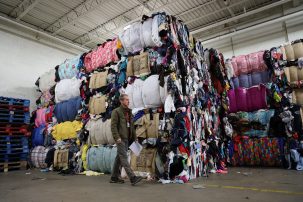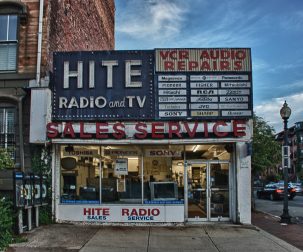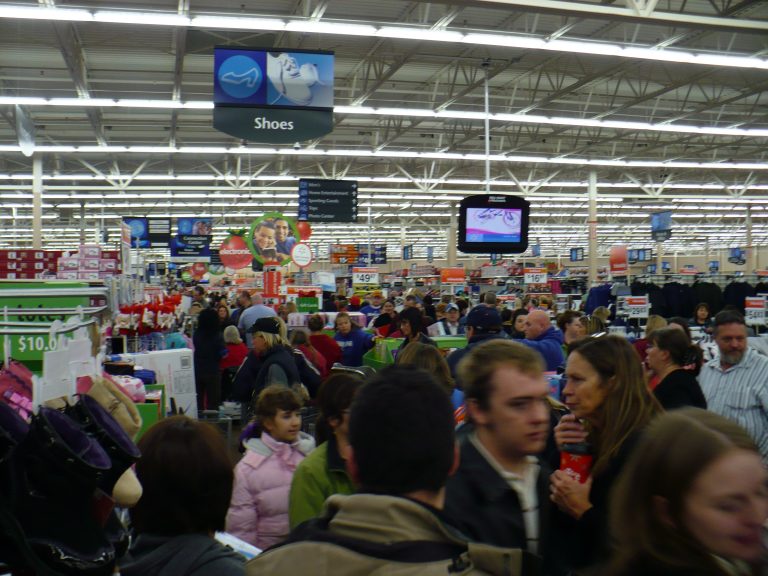Walmart on a Black Friday. Photo: Laurie
Did you know that Americans produce 25 percent more waste than usual between Thanksgiving and New Year’s Day, sending an additional one million tons a week to landfills? This COVID-19 holiday season, with online shopping the preferred gift giving method for many, we will likely generate even more waste mailing packages all over the country. In addition, over two billion Christmas cards are mailed every year, with enough paper to fill a football field 10 stories high. More than 38,000 miles of ribbon are thrown away and usually end up in landfills. Over the holidays, Americans discard half their total yearly paper waste, mostly holiday wrapping and decorations—about nine billion tons. And each person wastes almost 100 pounds of food.
What’s all this got to do with climate change?
In fact, our consumer habits are actually driving climate change. A 2015 study found that the production and use of household goods and services was responsible for 60 percent of global greenhouse gas emissions. Not surprisingly, wealthy countries have the most per capita impact. A new U.N. report found that the richest one percent of the global population emit more than twice the amount than the poorest 50 percent; moreover, the wealthier people become, the more energy they use. A typical American’s yearly carbon emissions are five times that of the world’s average person. In 2009, U.S. consumers with more than $100,000 in yearly household income made up 22.3 percent of the population, yet produced almost one-third of all U.S. households’ total carbon emissions.
As more people around the world enter the middle class and become affluent, the problem is worsening.

After basic needs are met, consumers begin buying items for social status; as people try to acquire more and more status, more and more expensive status products are needed. Producing all these things generates climate-changing greenhouse gas emissions. And in fact, across its life cycle, the average product results in carbon emissions of 6.3 times its own weight, according to a study done by Christoph Meinrenken, associate research scientist at the Earth Institute’s Research Program on Sustainability Policy and Management.
Technology can provide energy efficiency measures that help combat climate change, but “consumption (and to a lesser extent population) growth have mostly outrun any beneficial effects of changes in technology over the past few decades,” according to a June paper. The research concluded that it is not enough simply to “green” consumption by buying more sustainably produced goods—it is essential to reduce consumption. This is because 45 percent of global greenhouse gas emissions comes solely from the production of the things we use and buy every day.
The problem with stuff
While large oil companies like ExxonMobil, Shell, BP, and Chevron are the biggest emitters of greenhouse gas emissions, we consumers are complicit. We demand the products and energy made from the fossil fuels they provide. One scientist found that 90 percent of fossil fuel companies’ emissions are a result of the products made from fossil fuels.
The accepted wisdom about the economy has been that consumption is essential to economic growth, since our demand for things makes companies profitable and provides employment.

To keep this engine running, companies intentionally plan obsolescence of their products by changing how they look, such as in the fashion industry, or updating the design or software of products and discontinuing support for older models. Prices are kept artificially low to encourage us to buy because the real costs of their creation—which should include their environmental and social justice impacts—are not figured in. So we keep buying, and as a result, only one percent of “stuff” is still in use six months from its purchase, according to Annie Leonard’s The Story of Stuff, the iconic 2007 film.
The psychology of consumption
After World War II, consumer spending was encouraged because the U.S. economy needed to rebuild. People splurged on new appliances such as washing machines, refrigerators, and televisions and cars.
Advertisers perfected strategies to keep people buying by exploiting our emotions, such as fears of what would happen if we didn’t buy a product, our need not to miss out, or our desire to be more attractive. By 1960, Vance Packard wrote in his classic book, The Wastemakers, “The lives of most Americans have become so intermeshed with acts of consumption that they tend to gain their feelings of significance in life from these acts of consumption rather than from their meditations, achievements, inquiries, personal worth, and service to others.”
For many today, leisure time is often spent shopping, but the pleasure it provides — getting a thrill from newness or a bargain, escaping one’s problems, or reveling in the status of owning the latest thing — is fleeting. This is because it is linked to the act of buying, not the product itself. If we really loved the products we purchased, we would take better care of them and not want to replace them.
Becoming more conscientious consumers
COVID-19, with its enforced restrictions on our usual activities, is showing many people that it’s possible to live happier, simpler and less materialistic lives. According to one Vox reporter’s survey, the number one change people said they wanted to maintain after the pandemic was to reduce their consumerism.
To help change consumption habits, Sandra Goldmark, director of Campus Sustainability and Climate Action at Barnard College and theater professor, has adapted Michael Pollan’s advice about food (“Eat food. Not too much. Mostly plants.”) to stuff: “Have good stuff (not too much), mostly reclaimed. Care for it. Pass it on.”
The tools people employ to change any habits, such as food or exercise, can be applied to consumption. Goldmark recommends starting small and setting realistic goals. “I always think that it helps to show people that they’re already engaging in a lot of these kinds of ‘healthy stuff’ activities,” she said. “For example, a lot of people already love buying used items in certain categories. So if you can just explain to them the incredible impact of shifting your ‘stuff diet’ from new to used, they might be like, ‘Wow, I’m already doing that.’ And then it becomes a question of turning up the volume on certain behaviors and turning down the volume on other behaviors.” Recognizing that one is already practicing some good habits makes expanding them feel achievable.
People can be motivated to change their consumption habits for different reasons. For some, awareness of environmental impacts might be key, such as the pushback that occurred after the environmental impacts of fast fashion were exposed. For others, it might be saving money—for example, the ability to get a great deal on outdoor gear. “There are people whom I’ve spoken to about those used gear sites that are super excited, because they know they can get expensive high quality Patagonia or REI gear at a really low price,” said Goldmark. “They don’t really care so much about the environmental part, or for them, that’s just a bonus.”
When making purchases, she recommends looking for good materials and design, and repairability. In her new book, Fixation, Goldmark, wrote, “Good stuff is well designed for a long life cycle, made of the right materials, has parts that are easily available and replaceable, and was produced in a socially and environmentally ethical process.”
And when buying a new appliance or device that claims to be more energy efficient, take into account the energy that was embodied in its production — consider the life cycle carbon implications of goods.
Meinrenken’s study found that 45 percent of a product’s total carbon emissions occurs upstream in the supply chain — in other words, from the sourcing of and type of raw materials that go into the product. The Carbon Catalogue he helped create provides a side-by-side comparison of the carbon footprints of 866 products made in 28 countries. When shopping for certain types of items, you can compare carbon emissions. For example, a pair of Levi Strauss Rigid Tank jeans produces 7.7kg of carbon emissions equivalent over its life cycle, whereas Levi Strauss Tumble Rigid jeans produce 16 kg.
What government policies could help?
Some products are designed to be difficult or impossible to repair when they break, either because they are glued together or contain proprietary parts that require a special tool to make repairs. These constraints mean that when the product breaks, it is almost always destined for a landfill. To avoid this, Goldmark says that a policy requiring the repairability of products would be a good start. She noted that in 2021, France will introduce a repairability index that indicates how easy certain consumer products are to repair.
She also would like to see repair providers get tax rebates and “pay as you throw waste collection” which would enable people to feel the cost of their consumption. But ultimately, she said, “Until people are being paid a living wage to make our products, the prices are going to be artificially depressed, and the circular economy is going to have a hard time keeping up with the new goods economy. So international wage standards would be huge.”

Better holiday traditions
A recent IBM survey found that 54 percent of consumers polled are willing to change their holiday purchasing habits to reduce environmental impacts and 44 percent reported that they would take sustainability into consideration while shopping. Here are some ideas for more sustainable gift giving.
Gifts
Remember that many electronics, toys and clothing include plastics. Plastic is difficult to fix if it breaks, and plastic waste is likely to wind up in the ocean, where it is consumed by marine animals, or littering beaches in even the most remote places on Earth. Microplastics can expose living beings to harmful chemicals, some of which have been linked to health problems including cancers. Electronics also contain rare metals that often end up in landfills. So before you buy a product, think about its environmental impact.
Consider giving gifts made of bamboo, glass, metal or something edible made from local foods.

Give a gift that is useful and always supply gift receipts. If doing Secret Santa, let people know exactly what you want so there’s no waste. Handmade gifts, locally made gifts, experiential gifts, such as tickets to a Zoom event, or a gift of your time and skill are also good alternatives. Regift something someone gave you to a friend who’d appreciate it more. Or make a donation on someone’s behalf.
Avoid online shopping if possible because the packaging and delivery generate added carbon emissions. Instead, go to the store yourself, and preferably support your local merchants.
Wrapping
Use brown paper bags, newspaper, maps, colorful pages from catalogs, or kids’ artwork as wrapping. Avoid shiny gift wrap — it is usually not recyclable because it includes foil, heavy ink, or glitter, which is usually made of microplastics.

Wrap presents with old pieces of fabric with Japanese Furoshiki techniques.
Instead of ribbon or tape, use recycled string. Make bows out of colorful magazine pages. Cut up old holiday cards to make gift tags.
Holiday gatherings
This year, because we should avoid unnecessary travel, most celebrations are likely to be small family affairs. Cook local foods or host a potluck. Instead of dinner, just serve dessert and provide reusable containers for people to take home leftovers.
Your actions count
Individuals sometimes feel that their actions are too insignificant to make a dent in climate change, but individual actions can become social trends that make a difference. In Fixation, Goldmark wrote, “Together, our individual actions add up to collective actions — to our culture. And the choices we make in our daily lives influence the choices we make as families, as communities, and ultimately, influence the choices we make at the ballot box, where we can come together to scale and multiply those many individual choices.”
Article Credit: blogs.ei.columbia.edu
